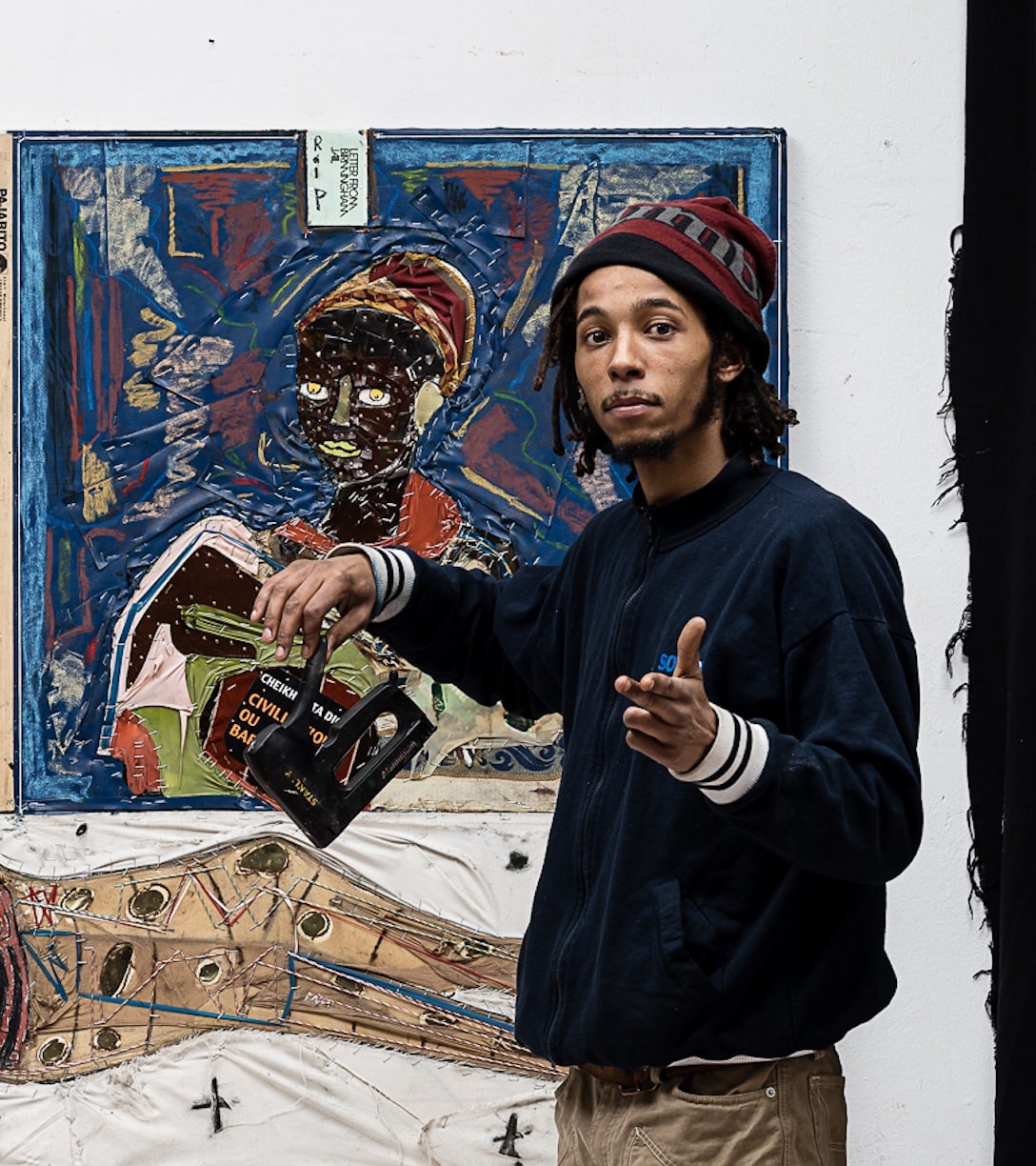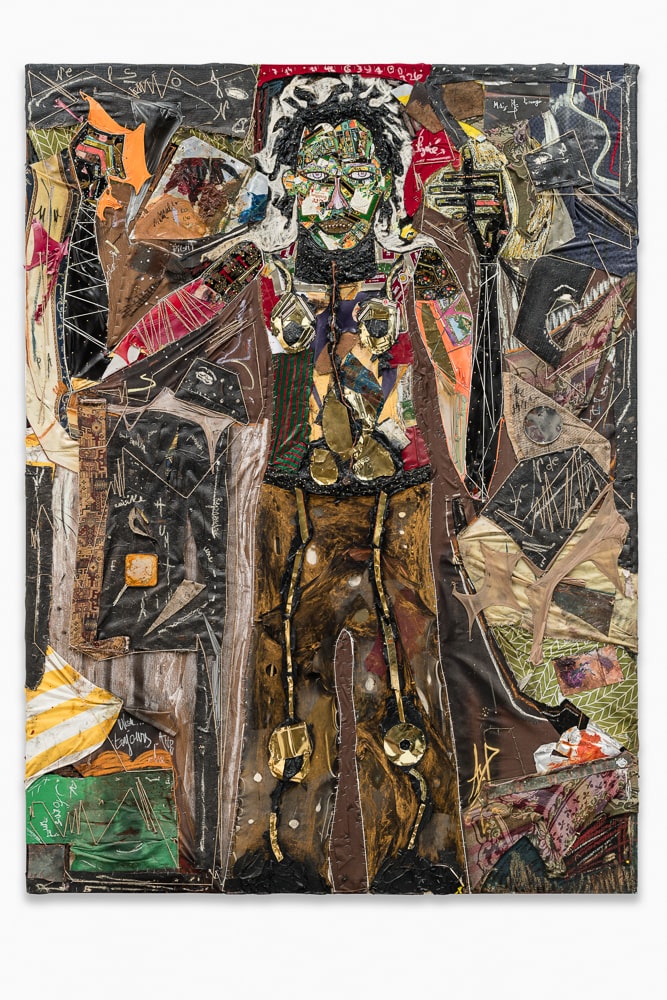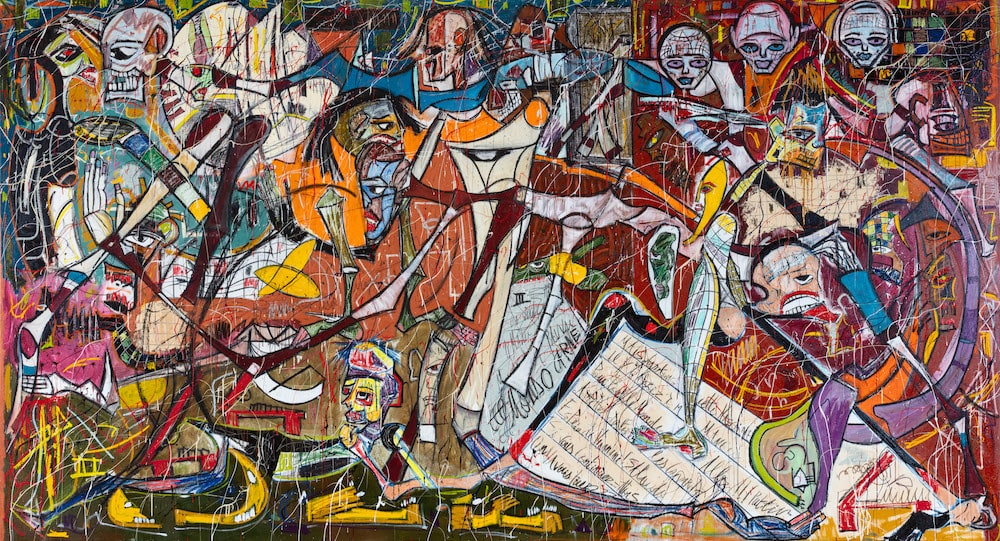The works of Alexandre Diop present a multitude of cultural, socio-political, and art-historical references that draw us deeply into the artist’s mind. Considering the musical and literary references, his use of symbolism and metaphor takes us beyond the immediate texture that defines the aesthetics of his work that’s created with discarded, damaged, and forgotten materials. His references allude to the deep intellectual space that is an integral layer of his practice and constitutes an essential part of the works’ materiality—conceptually and based on ontological explorations.
The initial point of entry to the works is the objects Diop finds on the streets and all around him. Nails, rope, plastic, latex, tar, tins, packaging material, candy wrappers, wires, book pages, fabric, cauri shells, beads, etc. He strings them together with a unique painterly approach to create figures and imagery. As we see the shapes and details, we encounter what they are, and by extension who Diop is. Each choice and each component placed on the canvas has a reason. It may at first appear as simply aesthetic, but the silver or gold of a discarded tin lends a royal glow to his protagonists. The branding on trashed food items speaks not just to the artist’s movements and travels but conveys a cultural context. They, in many instances, question relationships, consumer culture, and how heritage defines our interpretations of the world.

Portrait of Alexandre Diop by Jorit Aust.
Plastic and wood sections may show burn marks as fire is a recurring metaphor in Diop’s work. The blackened and curled plastic edges almost still carry the scent as we are asked to accept the damage in a newly emerging reality. Diop is a true creator as he understands reality yet immediately alters it to create a different version that he asks us to follow him into. Using pieces of objects, vessels, and containers such as discarded cookie jars or cans, the artworks themselves become containers that hold meaning. The artwork, too, is akin to a container or “the soul of the project,” as Diop calls it. Its makeup contains history, references, and identity notions. There are hints of self-reflection that merge into a grander picture of connections between space and landscape, identity markers and contemporary politics, history and art history, whilst simultaneously claiming its rightful place within.
Diop studies other artists with a keen eye and open mind, whether examining Jean-Michel Basquiat, Alberto Giacometti, or Picasso, and gaining inspiration from Cubism, Pop Art, Dadaism’s intent to disrupt elitism, or the Art Povera movement’s unconventional processes and use of everyday materials. He equally pays attention to his contemporaries, whether filmmakers, dancers, musicians, or visual artists like Robin Rhode, Amoako Boafo, Kennedy Yanko, or Basil Kincaid.
Diop’s considerations go beyond the immediate significance of any of his works. He thinks of what it may mean in the future, how it will age and change, and how his type of materiality will remain alive. This applies very directly to the possibility that the actual materials will change and shift with time, fade in color, and move with exposure to weather conditions, while the intellectual materiality within remains.
To quote Diop: “You need to be honest with yourself. I think painting is not enough, only a sculpture or drawings. For me, it’s important to do everything and/or to touch everything, to learn from everything. I think it’s important to surprise yourself and to surprise the viewer. The most efficient work is a painting that’s alive and real. I am not a painter who tries to create illusions. I think I’m a painter who tries to show a reality that comes from our own world already. I don’t try to create something. I try to show something that people maybe try to ignore or that they don’t think it’s important.“
The artist says that “art is an act of emancipation.” Diop does not allow any confinements or norms created by others to limit his approach to life, thought, and the creative process. Diop wants to be free from material limitations or boundaries of medium. He is free to insert references that at times may allude to his heritage or political commentary without allowing his practice to be shaped or defined by it. He lets the audience and space insert interpretations and consider possible definitions.
Most of the works initially invite the viewer in via one or more central figures who are often inspired by the artist himself as well as people he encounters: jazz musicians who were a significant inspiration especially during the artist’s time spent in Berlin, or major historical personalities like Malcolm X. We often also encounter pregnant women, and monkeys or figures with animal features. But even in this initial layer of the work, the figures do not abide by the laws of contemporary society or function within a world bound by contemporary reality. Their bodies may be distorted, they do not have to consider rules or laws. They can be violent and angry, and they can force us to reckon with ideas we did not even think of questioning before. Even in the most monumental of Diop’s works that can demand extreme levels of attention and intellectual space, there are moments of silence, moments of reflection and pause, where the viewer can insert themselves in between layers of physical texture, tactility, and conceptual framework. The size also demands respect and claims agency as it is impossible to not gaze upwards and bestow even figures perceived as vile, violent or outcasts with dignity. There always remains additional space for performance and immersion, albeit not immediately perceptible upon observation, as the works are often densely occupied by the artist’s gestures. Whether a central figure or an array of layered ideas that may appear cluttered, the work has structure and invites experiences and thoughts to be added, continuing the artist’s quest for the shedding of limitations.
Diop ultimately challenges with an expression of mind. He stimulates every sense so we can almost smell the burn, perceive his movements, and feel his intensity during the creation process even after completion. He is never absent from the work. The energy persists and we can hear jazz music, hip hop beats and his own voice resonating off the walls. There is movement, fluidity, continuity. We cannot grasp a beginning or end regardless of how much or how little negative space is provided. The story doesn’t end by what we immediately perceive.
We can see stitching and gluing and a merging of materials, visible and literal at first. Wires connect latex to Hershey’s wrappers that mark a shoulder, but the references and material layers extend into the intellectual and conceptual spaces of the work and connect directly with the viewer. The works invite to dance, sing, read, think, engage. A third extension is the think space of Diop himself. We may not always see a literal depiction of cultural references by finding a book cover somewhere on the canvas. But he would have read it anyway and not provided us with the direct interpretation. The third layer we must find on our own as we share the canvas with Diop and so many thinkers that are part of his research and being.
The writings, words and thoughts of James Baldwin, Cheikh Anta Diop, Frantz Fanon, Paul Gilroy, Édouard Glissant, curators, and artists resonate throughout the works, whether we see pages or covers of their writing or books embedded in the surface of the artworks, or we find references to their words, ideas and thought processes. We recurringly meet the mind and likeness of Baldwin or of Cheikh Anta Diop, a philosopher and writer foundational to the Afrocentrist movement, known for his questioning of postcoloniality and explorations on notions of cultural identity, cultural bias and extensive research on Diaspora and Diasporic identities. In many instances Diop himself simply creates, inspired by reading and engaging with their ideas. Black thinkers make prominent appearances in his work, although Diop does not create work that directly aims to discuss current affairs, race or identity politics, but doesn’t believe in a singular idea of himself, especially when moving across spaces that have shifting definitions and cultural context that alter the definition of him in relation to the immediate society or environment.
Legibility is one of Diop’s concerns when it comes to language, cultural references and connotations embedded in the works. To be legible, something must make immediate sense. He finds legibility not within the metaphysical aspects of his work, or within subjective interpretation of meaning, but rather in the corporal facts embedded within the materials themselves. The context may shift depending on the space the work is encountered in. What languages do we communicate in? What visual gestures and markers connect, and how are they interpreted by who is sharing the exhibition space? Conceptual depth needs to be legible beyond intentionality, and any observations that are ontological in essence must offer a space for multifaceted dialogue.
This dialogue cannot be restricted by language. Just as the artist retains freedom and experimentation, narrow interpretations would remove the space that the intellectual materiality of the work needs to thrive and make an impact. As aforementioned, the book pages and literary references are merged in many of Diop’s works with his own words. The text he infuses into the canvas often stems from his own writings and song texts he has created as a musician. Diop is a true interdisciplinary artist. His entire creation process is a dance with the world. The way he works with materials to compose his paintings is not different from how he shapes the world with lyrics and music. The overlapping words and layers of painted visual meaning create a truly poetic new reality, maybe with aspects or hints of illusion, to make us see what we have ignored before. This notion ties together the immediate and intellectual materiality as we are repeatedly encouraged to see anew, to think anew. Alexandre Diop ultimately takes us into a space where we are asked to connect emotionally and intellectually. We are immersed beyond a visual exploration. What we see, and the tactility and textures we observe in the work are merely a point of departure to deeply engage even after leaving the presence of the works. The marks and gestures that hint at a past while meeting us in the present allow Diop to share his own connections to life in art and let us do the same.

Alexandre Diop, “Nelson Mandela,” 2021, 252.5 x 185.5 x 4.8 cm, courtesy of the artist.







